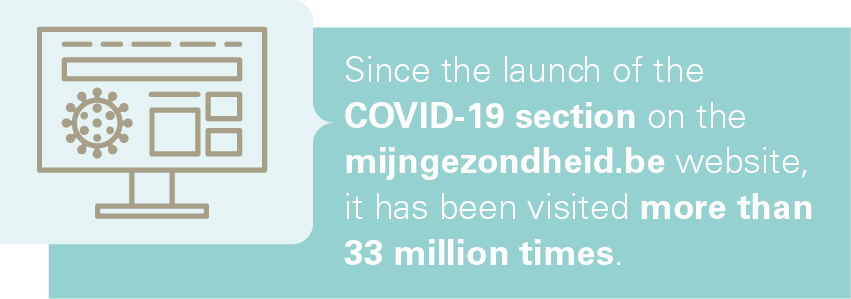- Details
On 12 March 2020, the federal phase of crisis management was declared in Belgium, meaning that from that point on, the COVID-19 pandemic was managed at national level. To this end, various consultation bodies were set up at national level, in which the different authorities and experts involved were represented. Within these bodies, various measures were drafted and taken to limit the spread of the virus.
- Details
Several centres were set up in the context of the COVID-19 pandemic. The triage and testing centres and the ‘transitional care’ centres are discussed below.
- Details

The graphic below shows some peaks in website visits. On the one hand, these peaks are related to new functionalities on the website such as consulting test results, requesting a PCR test, requesting the EU digital COVID certificate, and others. On the other hand, these peaks relate to the COVID-19 waves.
NUMBER OF VISITS TO WEBSITE MIJNGEZONDHEID.BE
In January 2022, the average number of daily visitors increased to ± 58,000 compared with ± 7,000 daily visits in January 2021.
Some improvements have already been integrated into the website:
- the COVID-19 sections were organised into 4 key themes for easy retrieval of information:
-
- Testing and results
- Self-isolation
- Vaccination
- EU Digital Covid Certificates
- The Frequently Asked Questions section was further updated to better meet the needs of citizens.
- Details
 |
In mid-March 2020, when it was confirmed that the influx of patients with COVID-19 into hospitals was increasing exponentially, the HTSC Committee (see above) took action by issuing national guidelines to general and university hospitals at regular intervals. |
The general and university hospitals were called upon to show solidarity and take responsibility by adopting the necessary measures to treat a maximum number of patients with COVID-19 infection according to their capacity and expertise. The hospitals were also asked to make arrangements within their networks to work together to deal with the influx of patients.
A daily overview of the number of admissions was needed in order to effectively monitor the situation in the Belgian hospitals. The hospitals registered the admission data and the available capacity via the Sciensano apps and via the Incident & Crisis Management System safety website respectively. On this basis, visual, dynamic dashboards were created to support the policy decisions.

